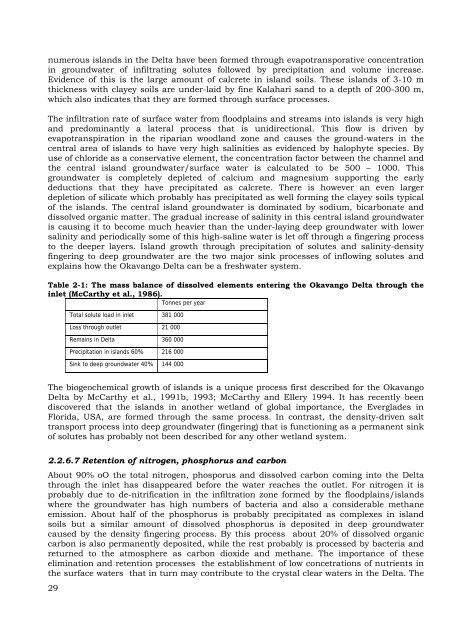Okavango Delta Management Plan - Ramsar Convention on Wetlands
Okavango Delta Management Plan - Ramsar Convention on Wetlands
Okavango Delta Management Plan - Ramsar Convention on Wetlands
Create successful ePaper yourself
Turn your PDF publications into a flip-book with our unique Google optimized e-Paper software.
numerous islands in the <str<strong>on</strong>g>Delta</str<strong>on</strong>g> have been formed through evapotransporative c<strong>on</strong>centrati<strong>on</strong><br />
in groundwater of infiltrating solutes followed by precipitati<strong>on</strong> and volume increase.<br />
Evidence of this is the large amount of calcrete in island soils. These islands of 3-10 m<br />
thickness with clayey soils are under-laid by fine Kalahari sand to a depth of 200-300 m,<br />
which also indicates that they are formed through surface processes.<br />
The infiltrati<strong>on</strong> rate of surface water from floodplains and streams into islands is very high<br />
and predominantly a lateral process that is unidirecti<strong>on</strong>al. This flow is driven by<br />
evapotranspirati<strong>on</strong> in the riparian woodland z<strong>on</strong>e and causes the ground-waters in the<br />
central area of islands to have very high salinities as evidenced by halophyte species. By<br />
use of chloride as a c<strong>on</strong>servative element, the c<strong>on</strong>centrati<strong>on</strong> factor between the channel and<br />
the central island groundwater/surface water is calculated to be 500 – 1000. This<br />
groundwater is completely depleted of calcium and magnesium supporting the early<br />
deducti<strong>on</strong>s that they have precipitated as calcrete. There is however an even larger<br />
depleti<strong>on</strong> of silicate which probably has precipitated as well forming the clayey soils typical<br />
of the islands. The central island groundwater is dominated by sodium, bicarb<strong>on</strong>ate and<br />
dissolved organic matter. The gradual increase of salinity in this central island groundwater<br />
is causing it to become much heavier than the under-laying deep groundwater with lower<br />
salinity and periodically some of this high-saline water is let off through a fingering process<br />
to the deeper layers. Island growth through precipitati<strong>on</strong> of solutes and salinity-density<br />
fingering to deep groundwater are the two major sink processes of inflowing solutes and<br />
explains how the <str<strong>on</strong>g>Okavango</str<strong>on</strong>g> <str<strong>on</strong>g>Delta</str<strong>on</strong>g> can be a freshwater system.<br />
Table 2-1: The mass balance of dissolved elements entering the <str<strong>on</strong>g>Okavango</str<strong>on</strong>g> <str<strong>on</strong>g>Delta</str<strong>on</strong>g> through the<br />
inlet (McCarthy et al., 1986).<br />
T<strong>on</strong>nes per year<br />
29<br />
Total solute load in inlet 381 000<br />
Loss through outlet 21 000<br />
Remains in <str<strong>on</strong>g>Delta</str<strong>on</strong>g> 360 000<br />
Precipitati<strong>on</strong> in islands 60% 216 000<br />
Sink to deep groundwater 40% 144 000<br />
The biogeochemical growth of islands is a unique process first described for the <str<strong>on</strong>g>Okavango</str<strong>on</strong>g><br />
<str<strong>on</strong>g>Delta</str<strong>on</strong>g> by McCarthy et al., 1991b, 1993; McCarthy and Ellery 1994. It has recently been<br />
discovered that the islands in another wetland of global importance, the Everglades in<br />
Florida, USA, are formed through the same process. In c<strong>on</strong>trast, the density-driven salt<br />
transport process into deep groundwater (fingering) that is functi<strong>on</strong>ing as a permanent sink<br />
of solutes has probably not been described for any other wetland system.<br />
2.2.6.7 Retenti<strong>on</strong> of nitrogen, phosphorus and carb<strong>on</strong><br />
About 90% oO the total nitrogen, phosporus and dissolved carb<strong>on</strong> coming into the <str<strong>on</strong>g>Delta</str<strong>on</strong>g><br />
through the inlet has disappeared before the water reaches the outlet. For nitrogen it is<br />
probably due to de-nitrificati<strong>on</strong> in the infiltrati<strong>on</strong> z<strong>on</strong>e formed by the floodplains/islands<br />
where the groundwater has high numbers of bacteria and also a c<strong>on</strong>siderable methane<br />
emissi<strong>on</strong>. About half of the phosphorus is probably precipitated as complexes in island<br />
soils but a similar amount of dissolved phosphorus is deposited in deep groundwater<br />
caused by the density fingering process. By this process about 20% of dissolved organic<br />
carb<strong>on</strong> is also permanently deposited, while the rest probably is processed by bacteria and<br />
returned to the atmosphere as carb<strong>on</strong> dioxide and methane. The importance of these<br />
eliminati<strong>on</strong> and retenti<strong>on</strong> processes the establishment of low c<strong>on</strong>cetrati<strong>on</strong>s of nutrients in<br />
the surface waters that in turn may c<strong>on</strong>tribute to the crystal clear waters in the <str<strong>on</strong>g>Delta</str<strong>on</strong>g>. The

















